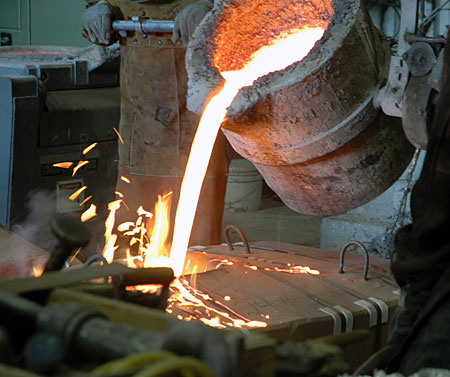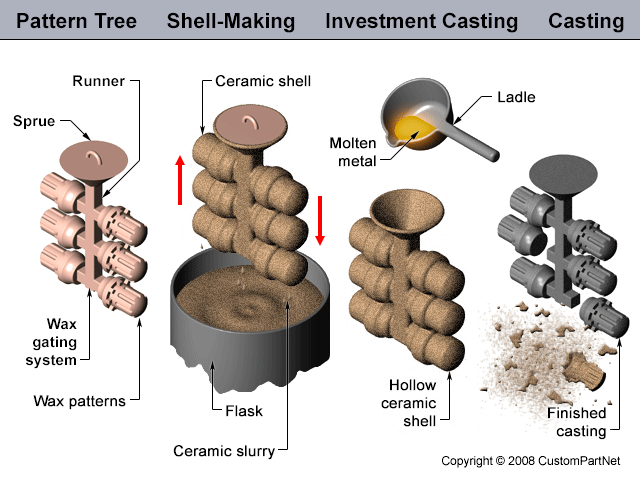Casting processes have been known for thousands of years, and widely used for sculpture, especially in bronze, jewellery in precious metals, and weapons and tools. Traditional techniques include lost-wax casting, plaster mold casting and sand casting.
The modern casting process is subdivided into two main categories: expendable and non-expendable casting.
The modern casting process is subdivided into two main categories: expendable and non-expendable casting.
Expendable mold casting
Sand casting
Sand casting is one of the most popular and simplest types of casting that has been used for centuries. Sand casting allows for smaller batches to be made compared to permanent mold casting and at a very reasonable cost.
Sand casting requires a lead time of days for production at high output rates (1–20 pieces/hr-mold) and is unsurpassed for large-part production. Green (moist) sand has almost no part weight limit, whereas dry sand has a practical part mass limit of 2,300–2,700 kg (5,100–6,000 lb). Minimum part weight ranges from 0.075–0.1 kg (0.17–0.22 lb). The sand is bonded together using clays, chemical binders, or polymerized oils (such as motor oil). Sand can be recycled many times in most operations and requires little maintenance.
Plaster mold casting
Plaster casting is an inexpensive alternative to other molding processes for complex parts due to the low cost of the plaster and its ability to produce near net shape castings. The biggest disadvantage is that it can only be used with low melting point non-ferrous materials, such as aluminium, copper, magnesium, and zinc.
Shell molding
Shell molding is similar to sand casting, but the molding cavity is formed by a hardened "shell" of sand instead of a flask filled with sand. The sand used is finer than sand casting sand and is mixed with a resin so that it can be heated by the pattern and hardened into a shell around the pattern.
Non-expendable mold casting
Non-expendable mold casting differs from expendable processes in that the mold need not be reformed after each production cycle. This technique includes at least four different methods: permanent, die, centrifugal, and continuous casting.
Permanent mold casting
Permanent mold casting is a metal casting process that employs reusable molds ("permanent molds"), usually made from metal. The most common process uses gravity to fill the mold, however gas pressure or a vacuum are also used. A variation on the typical gravity casting process, called slush casting, produces hollow castings.
Die casting
Most die castings are made from nonferrous metals, specifically zinc, copper, and aluminium based alloys, but ferrous metal die castings are possible. The die casting method is especially suited for applications where many small to medium sized parts are needed with good detail, a fine surface quality and dimensional consistency.
Terminology
Flask: The rigid wood or metal frame that holds the molding material.
Cope: The top half of the pattern, flask, mold, or core.
Drag: The bottom half of the pattern, flask, mold, or core.
Core: An insert in the mold that produces internal features in the casting, such as holes.
Core print: The region added to the pattern, core, or mold used to locate and support the core.
Mold cavity: The combined open area of the molding material and core, there the metal is poured to produce the casting.
Riser: An extra void in the mold that fills with molten material to compensate for shrinkage during solidification.
Gating system: The network of connected channels that deliver the molten material to the mold cavities.
Draft: The taper on the casting or pattern that allow it to be withdrawn from the mold
Core box: The mold or die used to produce the cores.




good bro
ReplyDelete